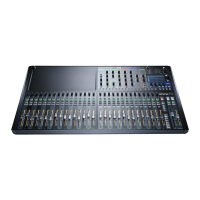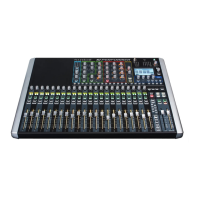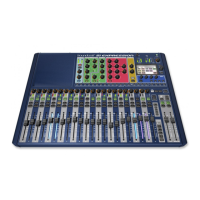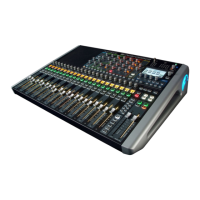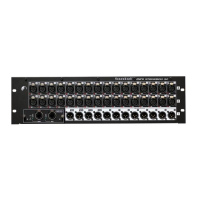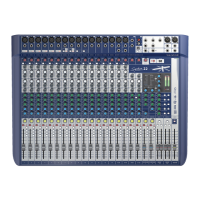
Do you have a question about the SoundCraft Signature 16 and is the answer not in the manual?
| Type | Analog |
|---|---|
| Channels | 16 |
| Mic Preamps | 12 |
| Aux Sends | 4 |
| Faders | 100mm faders |
| Phantom Power | Yes |
| Subgroups | 4 |
| Headphone Outputs | 1 x 1/4" |
| EQ Bands | 3-band |
| Inputs - Line | 8 x 1/4" |
| Inputs - Other | 2 x RCA |
| Outputs - Main | 2 x XLR |
| Outputs - Other | 4 Aux |
| Main Outputs | 2 |
| Monitor Outputs | 2 x 1/4" |
Please read this manual carefully before using your mixer for the first time.
General overview of the Signature Series mixers, highlighting key features.
Details the 40-year legacy of Soundcraft and its classic analogue designs.
Explains the Soundcraft Sapphyre Asymmetric EQ and its features.
Provides important safety notices and explains warning symbols.
Lists general warnings for safe operation and maintenance of the apparatus.
Further warnings regarding hearing protection and FCC compliance.
Details the terms and conditions of the product warranty.
Lists the technical specifications of the Soundcraft Signature series.
Guides new users on how to approach the manual and the console.
Explains the fundamental functions of a mixing console and its features.
Describes the physical inputs and outputs of the console.
Details the features and connections of mono input channels.
Explains the stereo input channels and their functions.
Describes the FX Return channel and its purpose.
Explains the controls for internal Lexicon FX processors.
Describes the master stereo output and its controls.
Details headphone level, phantom power, and USB power controls.
Explains the controls for auxiliary output buses.
Details the group master output controls and routing.
Describes the physical inputs and outputs of the console.
Details the features and connections of mono input channels.
Explains the stereo input channels and their functions.
Describes the FX Return channel and its purpose.
Explains the controls for auxiliary output buses.
Details the group master output controls and routing.
Describes the master stereo output and its controls.
Explains the bargraph metering for monitoring signal levels.
Explains the controls for internal Lexicon FX processors.
Describes the power status indicator light.
Details the USB power socket for peripherals.
Explains the 48V phantom power switch.
Describes the control for headphone output volume.
Introduces the physical inputs and outputs of the console.
Defines terms related to audio inputs and outputs used in the manual.
Describes the various console input connections like XLR, Jack, and RCA.
Details the console output connections like MST, AUX, HEADPHONES, and GRP.
Covers additional I/O like USB, Footswitch, and Power connections.
Explains how signals flow through the console and routing options.
Details the signal path and routing options for mono input channels.
Explains the signal path and routing options for stereo input channels.
Details the signal path and routing options for FX Return channels.
Explains the routing and control of Aux Master outputs.
Details the routing and control of Group Master outputs.
Explains the routing and control of the Master Stereo output.
Introduces the different types of input and output channels.
Describes the controls found on the input channels of the console.
Details the specific controls for mono input channels.
Explains the High Pass Filter control.
Details the USB Return function for MTK models.
Describes the High Frequency shelving filter control.
Explains the centre frequency adjustment for mid-band EQ.
Details the boost/attenuation control for mid-band EQ.
Details the Low Frequency shelving filter control.
Explains control of channel contribution to Aux busses.
Details channel contribution to Aux and FX processors.
Explains the pan control for stereo positioning and routing.
Describes the pre-fade mute function.
Describes the LED indicators for signal peak and mute status.
Details the Pre-Fade Listen function.
Explains the channel fader for level control.
Describes routing channel output to Group busses.
Explains routing channel output to the Master bus.
Adjusts the input level for stereo line-level sources.
Adjusts channel contribution to Aux send busses.
Switches Aux 1 and 2 sources post-fader for Playback Channel.
Adjusts pan or balance for stereo position and routing.
Adjusts stereo balance for this channel.
Routes the channel output to Group busses.
Adjusts stereo balance for this channel.
Routes the channel output to Group busses.
Adjusts the level of the Aux mix output for the corresponding Aux bus.
Globally switches Aux sources between pre- and post-fade.
Routes the signal to the Solo bus and mutes other channels.
Switches Group-to-MST outputs to mono.
Routes the Group output to the Master Stereo mix.
Adjusts the overall output level of the Group.
Mutes all channels except the Stereo Playback channel.
Adjusts the overall level of the Master Stereo output.
Explains how to monitor sources individually using PFL and AFL.
Enables the Pre-Fade Listen function for input channels.
Switches the After-Fader Listen function for Aux Master outputs.
Adjusts the level of the headphone output.
Displays current monitoring signal levels.
Lights when a PFL or AFL is active.
Introduces USB 2.0 audio streaming for the consoles.
Details the 2-track USB input/output for Signature 16 and 22.
Explains the Multi-Track USB functionality for Signature 22MTK.
Explains the USB data connection.
Details the USB return path function.
Introduces the internal Lexicon FX processors and algorithms.
Explains how to use and control the Lexicon FX algorithms.
Describes the different reverb algorithms and their parameters.
Lists more reverb algorithms and their parameters.
Describes delay and modulation effects algorithms and parameters.
Lists more delay and modulation effects algorithms.
Covers Vibrato, Vibrapan, and Phaser effects algorithms.
Provides a troubleshooting guide for common sound issues.





